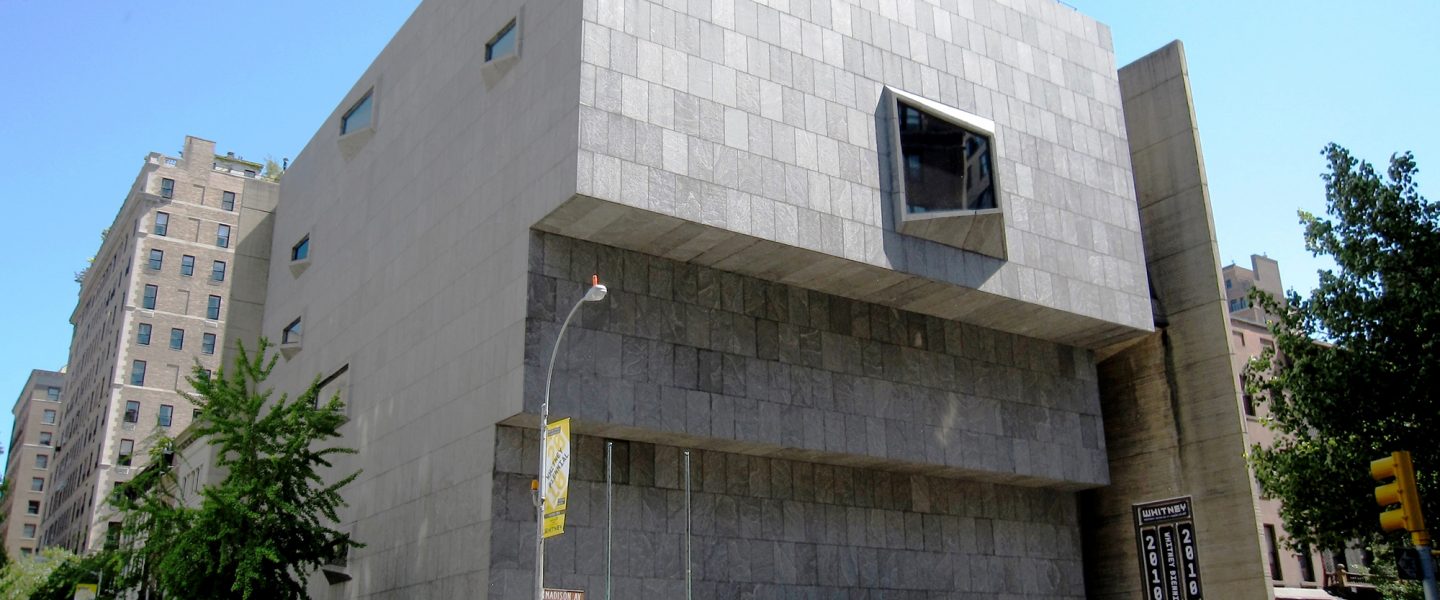A hallowed museum building becomes an auction house.
|
Listen To This Story
|
Since 1966, at the corner of Madison Avenue and 75th Street, a huge gray slab of cantilevered floors lurching over the sidewalk has marked a locus of modern painting and sculpture. The third incarnation of the Whitney Museum of American Art, Marcel Breuer’s celebrated building resembles a fortress in the shape of a friendly Cyclops, with a single bay window facing the avenue.
When the museum moved downtown in 2015, the Breuer building lay empty for two years until it was leased to the Metropolitan Museum and named the Met Breuer. In 2020 it became the Frick Madison, but now we learn that the iconic structure has been sold for $100 million — to Sotheby’s, the world’s largest auction house (if it isn’t Christie’s).
I initially greeted this news with some glee. The modernist Breuer masterpiece was a key stepping stone in my art education. I used to attend the Whitney biennials with a near religious fervor, and on one visit shared the large elevator with Andy Warhol (and his bodyguard).
This is a clever purchase for the auction house, but I’m not sure what art gets out of it.
I have nothing against auctions per se, and used to regularly attend them at Christie’s and Sotheby’s, regarding them as theatrical events offered for free — as long as you didn’t absently scratch your head and accidentally buy a Tiffany window.
Granted the Breuer building wouldn’t make a good office building or residential block. It has few windows (only that one overlooking Madison Avenue above the first floor) and no ramp to turn into a parking garage. Art is its engine, its raison d’etre. But in its new incarnation all the art will have price tags and be gone in a matter of days.
Auctions are where work can move through the economy and find new collections, but lately it’s where art has gone to die. Blue-chip paintings get snapped up by bored billionaires to place on a yacht wall or disappear into a Hong Kong basement with the security system of a Fort Knox. Museums can’t compete with such prices

The highest price for a work of modern art was an estimated $300 million for Willem de Kooning’s Interchange, second only to the $450.3 million spent on the supposed Leonardo da Vinci painting of Salvator Mundi (the provenance is disputed).
Warhol’s Shot Sage Blue Marilyn went for $195 million last year at Christie’s. The highest price Sotheby’s ever achieved was $157.2 million for Amedeo Modigliani’s Nu Couché in 2018. But they nabbed the top price for a full sale when they hammered off the Macklowe Collection last year for $922 million.
Hurrah.
I harp on these numbers only because the auction houses do so themselves. That’s what they’re about, racking up records as if they were running a racetrack (which essentially they are).
In 2002 Sotheby’s was fined £13 million (~$16.2 million) by the European commission for operating an illegal price-fixing cartel with its nemesis Christie’s for most of the 1990s.
The Breuer building is of course itself a work of art, which could have passed through the ledgers of Sotheby’s own real estate arm. Personally, if I had a hundred million onhand to spend on art, I’d rather buy the old Whitney shell than a third of a de Kooning or half shot blue Warhol (much as I like Warhol).
The entrance foyer long housed Calder’s whimsical wired circus, with a video showing the artist himself operating the ingenious gizmos. If I saw anything close to its beauty now in that building I’d fear for its life, knowing the days were ticking down to its hammered exit, with the likelihood of ever seeing it again being slim to none.
 Warhol long ago wittily toyed with the tangle of art and money, once offering a silk-screened painting of 200 one-dollar bills for $200 (it went for $43.7 million at Sotheby’s in 2009). It’s perhaps no surprise that it’s his work that has racked up records when tycoon collectors recognize his financial references without quite getting the joke.
Warhol long ago wittily toyed with the tangle of art and money, once offering a silk-screened painting of 200 one-dollar bills for $200 (it went for $43.7 million at Sotheby’s in 2009). It’s perhaps no surprise that it’s his work that has racked up records when tycoon collectors recognize his financial references without quite getting the joke.
Whatever you think of that alleged da Vinci Salvator Mundi, no one’s seen it since it was sold at Christie’s. The auction houses like to trumpet the prices they achieve for art, but not who bought it. That’s because you’re unlikely to see it again. That Modigliani that went for a record price at Sotheby’s had been exhibited at the Tate Modern, but good luck finding it now.
I’m not arguing that no great art should be in private hands. But it shouldn’t be treated as a kind of cryptocurrency with which to park money. The great New York museums (the Met, MoMA, the Guggenheim, and the Whitney itself) were all established by rich families and started off with work from their own collections. But this new class of mogul is parsimonious with its wealth and unwilling to share its possessions.
Steve Wynn, the casino magnate, once stuck his left elbow through Picasso’s painting Le Reve, a portrait of his lover Marie-Therese Walter. He’d recently bought it for something north of $50 million and was about to resell it. No doubt he would have liked to have kept it a secret, but there were several journalists in the room when it happened, including Nora Ephron and her husband Nicholas Pileggi.
At least the Breuer building is unlikely to get damaged, and we’ll always know where it is. Next time I’m in New York I may well drop by to take a look, knowing full well that any artwork I see is not long for public display. Going, going, gone.
—
J.B. Miller is an American writer living in England, and is the author of My Life in Action Painting and The Satanic Nurses and Other Literary Parodies.




